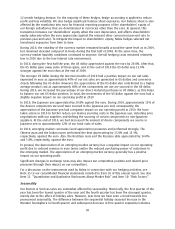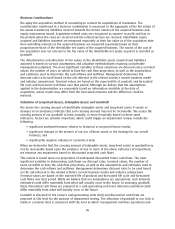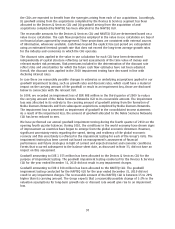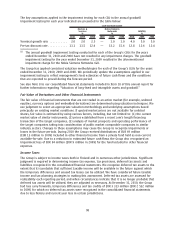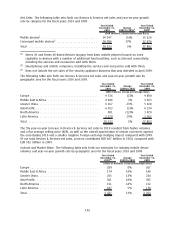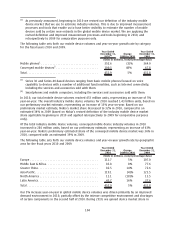Nokia 2010 Annual Report Download - page 98
Download and view the complete annual report
Please find page 98 of the 2010 Nokia annual report below. You can navigate through the pages in the report by either clicking on the pages listed below, or by using the keyword search tool below to find specific information within the annual report.the CGUs are expected to benefit from the synergies arising from each of our acquisitions. Accordingly,
(i) goodwill arising from the acquisitions completed by the Devices & Services segment has been
allocated to the Devices & Services CGU and (ii) goodwill arising from the acquisition of and
acquisitions completed by NAVTEQ has been allocated to the NAVTEQ CGU.
The recoverable amounts for the Devices & Services CGU and NAVTEQ CGU are determined based on a
value in use calculation. The cash flow projections employed in the value in use calculation are based
on financial plans approved by management. These projections are consistent with external sources
of information, whenever available. Cash flows beyond the explicit forecast period are extrapolated
using an estimated terminal growth rate that does not exceed the longterm average growth rates
for the industry and economies in which the CGU operates.
The discount rates applied in the value in use calculation for each CGU have been determined
independently of capital structure reflecting current assessments of the time value of money and
relevant market risk premiums. Risk premiums included in the determination of the discount rate
reflect risks and uncertainties for which the future cash flow estimates have not been adjusted.
Overall, the discount rates applied in the 2010 impairment testing have decreased in line with
declining interest rates.
In case there are reasonably possible changes in estimates or underlying assumptions applied in our
goodwill impairment testing, such as growth rates and discount rates, which could have a material
impact on the carrying amount of the goodwill or result in an impairment loss, those are disclosed
below in connection with the relevant CGU.
In 2009, we recorded an impairment loss of EUR 908 million in the third quarter of 2009 to reduce
the carrying amount of the Nokia Siemens Networks CGU to its recoverable amount. The impairment
loss was allocated in its entirety to the carrying amount of goodwill arising from the formation of
Nokia Siemens Networks and from subsequent acquisitions completed by Nokia Siemens Networks.
The impairment loss is presented as impairment of goodwill in the consolidated income statement.
As a result of the impairment loss, the amount of goodwill allocated to the Nokia Siemens Networks
CGU has been reduced to zero.
We have performed our annual goodwill impairment testing during the fourth quarter of 2010 on the
opening fourth quarter balances. During 2010, the conditions in the world economy have shown signs
of improvement as countries have begun to emerge from the global economic downturn. However,
significant uncertainty exists regarding the speed, timing and resiliency of the global economic
recovery and this uncertainty is reflected in the impairment testing for each of the Group’s CGUs. The
impairment testing has been carried out based on management’s assessment of financial
performance and future strategies in light of current and expected market and economic conditions.
Events that occurred subsequent to the balance sheet date, as discussed in Note 33, did not have an
impact on this assessment.
Goodwill amounting to EUR 1 355 million has been allocated to the Devices & Services CGU for the
purpose of impairment testing. The goodwill impairment testing conducted for the Devices & Services
CGU for the year ended December 31, 2010 did not result in any impairment charges.
Goodwill amounting to EUR 4 368 million has been allocated to the NAVTEQ CGU. The goodwill
impairment testing conducted for the NAVTEQ CGU for the year ended December 31, 2010 did not
result in any impairment charges. The recoverable amount of the NAVTEQ CGU is between 15 to 20%
higher than its carrying amount. The Group expects that a reasonably possible change of 12% in the
valuation assumptions for longterm growth rate or discount rate would give rise to an impairment
loss.
97





